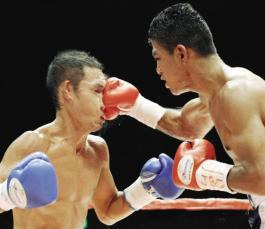
|  |  |  Editorials | Opinions | July 2009 Editorials | Opinions | July 2009  
A Blow to the Head and the Health
 Michael Staples - Daily Gleaner Michael Staples - Daily Gleaner
go to original
July 29, 2009


| | Nicaraguan champion Roman Gonzalez lands a right on the face of Japanese challenger Katsunari Takayama in the sixth round of their 12-round scheduled WBA minimumweight title bout in Kobe, western Japan on July 14. Gonzalez retained his title with a unanimous decision. Columnist Michael Staples believes the head injury risks in boxing, fighting in hockey and ultimate fighting outweigh the entertainment value. Nearly 900 boxers have died as a result of brain injuries in the ring in the last 90 years. (Associated Press) |  |
It doesn't take a brain surgeon to arrive at the conclusion that pounding on someone's head has the potential to cause some pretty bad damage.

Any bang or knock to the cranium, sometimes even the most minor of incidents, can result in serious internal injuries.

But yet we see it constantly at live events and on television these days in the form of organized fighting.

The danger associated with such sports was brought to the forefront recently when Mexican junior welterweight Marco Antonio Nazareth, 23, died at a hospital in Puerto Vallarta. His death occurred four days after sustaining a brain hemorrhage in a loss to Omar Chavez.

Hospitalized after the fight, Nazareth was knocked down in the first round and knocked out in the fourth.

Despite surgery immediately after the fight, the young man's condition rapidly deteriorated and he eventually succumbed to his injuries.

Whether the death of Nazareth will spark a debate, such as that which occurred following the 2005 death of American Leavander Johnson, will remain to be seen.

Johnson died after brain surgery following a loss to Mexican Jesus Chavez.

According to accounts of that fight, Johnson absorbed at least two dozen unanswered punches to the head and body.

Johnson's death led to many people calling for the sport of boxing to be banned all together.

The Spokesman-Review of Spokane, Wash., said in an editorial written at the time that nearly 900 boxers have died as a result of injuries in the ring since 1920.

The newspaper asked for the sport to be banned.

"Even among prizefighters who walk away, the American Association of Neurological Surgeons estimates 15-40 per cent of ex-boxers have some form of chronic brain injury and most professional fighters - whether they have apparent symptoms or not - have some degree of brain damage," the newspaper wrote.

Although those remarks are now close to four years old, their importance comes to bear every time a preventable death occurs in the ring.

Traumatic brain injuries, according to experts, are caused by "a blow or jolts to the head" or as "a penetrating head injury that disrupts the function of the brain."

But now the art of fighting and targeting the head have jumped into another more concerning phase with the evolution of the ultimate fighting craze.

If fatal blows can be delivered by someone wearing boxing gloves, what's going to happen when someone is beating at a person's head with bare fists?

The recent image in prime time of one fighter having another pinned to the canvas of a ring and pounding as hard as he could on his opponent's bloody head is not something a person is likely to forget any time soon.

Targeting of the head, however, is just not restricted to boxing or other types of amateur or organized fighting. It happens at a rabid pace in hockey.

Diehards argue that fighting is a part of the game and cannot be removed.

But it can be if desire ever reaches the point where it outweighs greed.

The image of two hockey players pummelling heads is not a lovely sight to behold.

What kind of message does this send to young people who are still trying to come to grips with what is and is not appropriate behaviour?

The price of dealing with brain injuries in this country each year costs Canadians more than $1 billion.

Some of these injuries cannot be prevented because accidents will happen.

But others - those associated with organized fighting - can.

We have to start using more common sense.

Life is short enough as it is. Why hurry the process?

Michael Staples is a reporter/editor with The Daily Gleaner. He can be reached at Michael(at)dailygleaner.com. |

 |
|  |



